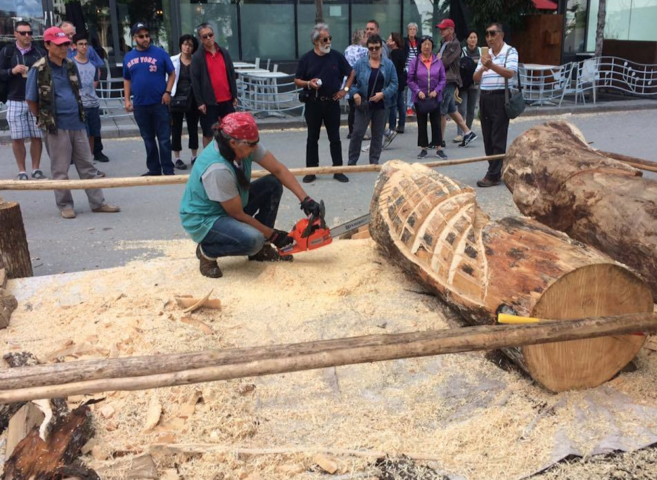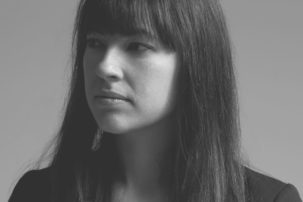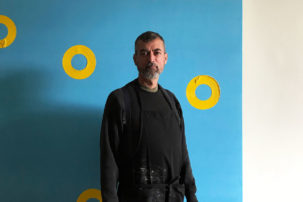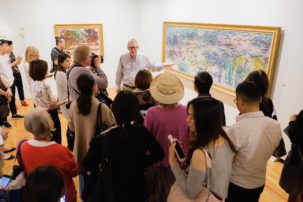Seven Canadian artists—and one curator—are each $25,000 richer today thanks to the 2018 Governor General’s Awards in Visual and Media Arts. The award, administrated by the Canada Council, is awarded to artists in recognition of remarkable careers in art.
Siksika artist Adrian Stimson is known for powerful material- and performance-based work, including the personae Buffalo Boy and the Shaman Exterminator. This past year, in homage to Indigenous soldiers, he held a performance where he dug a trench from sunup to sundown for five days straight. “He often will use real materials like buffalo hide or the remnants of the actual residential school that he attended in order to ground his camp aesthetic in an actual experience or material reality,” notes Art Gallery of Ontario assistant curator Wanda Nanibush of Stimson’s work in a release.
Also known for her evocative use of materials is winner Spring Hurlbut of Toronto. Hurlbut’s recent bodies of photo and video work document ashes and cremation remains as they settle onto surfaces or swirl into air. “Spring Hurlbut’s contemplative and eloquent works unsentimentally address mortality and our inevitable destiny in death,” states curator Jessica Bradley. “Her dedication to a subject so commonly avoided in contemporary Western culture is singular and courageous.”
Vancouver-based photographer Sandra Semchuk is another honouree. She is receiving recognition, in part, for her collaborative approaches to lens-based media. She made collaborative self-portraits as early as the 1970s and also worked in tandem with her partner James Nicholas prior to his sudden death in 2007. “Semchuk’s work reminds us of the necessity to continually rethink our positions as artists, as speaking subjects, as listeners,” said artist and nominator Althea Thauberger.
Work with others is a hallmark of artist Bruce Eves, also being recognized at the GGs this year. In 1975, Eves co-founded the Centre for Experimental Art and Communication in Toronto. As he has put it of the Toronto scene then, “There was the whole A Space, General Idea crowd and then there was the whole CEAC, leftist politics, gay liberation stuff at the other end, butting heads.” Performance artist and nominator Lily Eng states: “His commitment to the rigor of historical research—whether art history, gay history, or his own personal history—has been at the core of his work across his 40-year career.”
Filmmaker and media artist Midi Onodera “gained critical acclaim very early in her career with two remarkable films: Ten Cents a Dance (Parallax) (1985) and The Displaced View (1989),” notes nominator and performance artist Tanya Mars. Both “launched her reputation as a thoughtful, daring filmmaker”—including awards at international lesbian and gay film fests— “at a time when there was very little diversity in Canadian art.”
For one of his more recent works, London-based artist Wyn Geleynse turned a pair eyeglasses into a projection screen—another witty turn in a four-decade career of being “a restless tinkerer,” as artists and nominators Paul Walde and Andrew Wright put it. Geleynse was born in Rotterdam before moving to Canada in his youth, and his work is in the collection of the MIT List Center, among others.
A more classic material—namely, clay—comes to the fore in the work of Regina ceramic artist Jack Sures, winner of the GG’s Saidye Bronfman Award for fine crafts. “Over the past six decades, Jack Sures has displayed enormous creativity, innovation and technical mastery in Canadian craft,” states nominator and craft researcher Julia Krueger. Sures—who has also created large-scale murals in addition to small ceramic works—has influenced many other artists through his work at the University of Regina’s ceramics program.
Curator Glenn Alteen, who is program director at grunt gallery in Vancouver, receives the GG’s Outstanding Contribution Award this year. According to Vancouver Art in the Sixties, Alteen co-founded the LIVE Performance Biennial and has curated community-based projects such as The Mattering Map (1996) by Pia Massie, “which engaged old working class diner owners and patrons in…East Vancouver.” Alteen “has insisted on establishing—in grunt gallery—an artist-run centre that is more about artists than objects,” said artist nominator Lorna Brown.
The official GG awards ceremony will take place on March 28 at 6 p.m. at Rideau Hall in Ottawa, with an opening reception for a GG-related exhibition happening the next day, March 29, at 5:30 p.m at the National Gallery of Canada.
This post was corrected on February 12, 2018. The original copy misspelled Pia Massie’s last name.

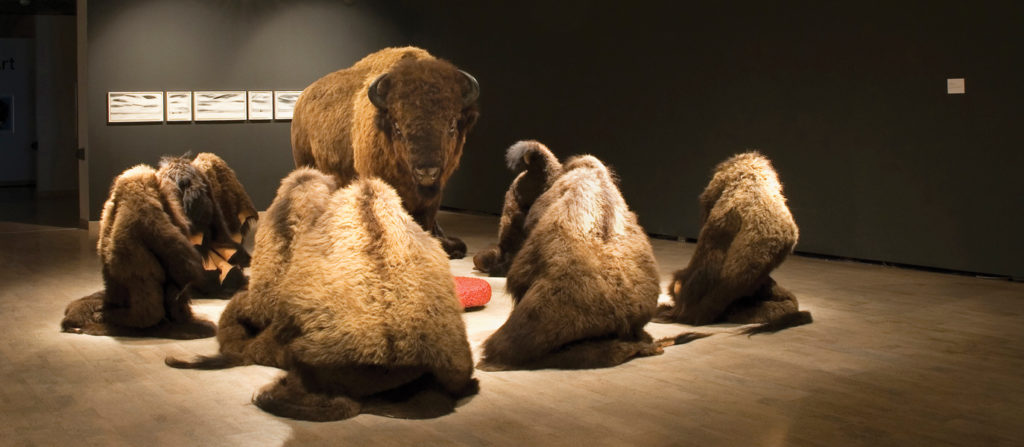 Adrian Stimson, Beyond Redemption, 2010. Bison mounted on painted wood platform, bison robes and wood crosses. Courtesy Mendel Art Gallery. Photo: Eve Kotyk.
Adrian Stimson, Beyond Redemption, 2010. Bison mounted on painted wood platform, bison robes and wood crosses. Courtesy Mendel Art Gallery. Photo: Eve Kotyk.
